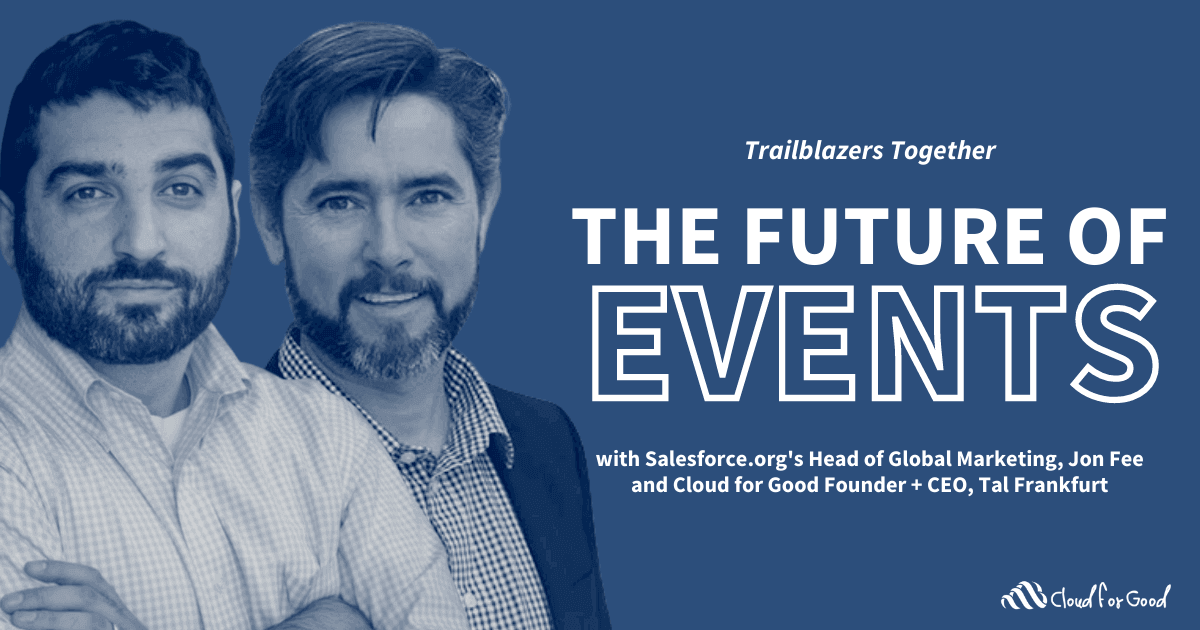2020 has been a year of massive change, and for marketing that has meant finding new, creative ways to engage with our donors, constituents, and friends. From events with thousands of attendees, like Salesforce.org’s Higher Education Summit, to on-camera zoom meetings – the way we approach connections has changed significantly this past year. I recently sat down (virtually) with the Head of Global Marketing at Salesforce.org, Jon Fee, to talk about the future of events and the reimagined virtual Trailblazers Together experience.
About Jon Fee: “I run Global Marketing for Salesforce.org. Scale distribution is my jam. I’m convinced music is magic. I’m a sucker for efficiency and data. When I’m not working, you can find me exploring the great outdoors (picking up trash) with my three boys, or holding a bass guitar.”
Tal Frankfurt (TF): I thought that Salesforce did a fantastic job with the first virtual Higher Education Summit earlier this year. What lessons are you taking from that event and applying to your next big event on December 9th, Trailblazers Together?
Jon Fee (JF): The Higher Ed Virtual Summit in June seems like it was a lifetime ago! It really was a fantastic event and, at the time, it exceeded expectations. Attendance was huge, the tech performed well, and more importantly, in-app community engagement was strong. We all learned a lot from that event, but we are cautious with regards to placing too much weight on those learnings given the event was six months ago.
Things have changed since June. Customer behaviors are changing at such an accelerated rate that we are having to get to know them all over again. From a pure marketing perspective, audience personas and journeys are vastly different year over year. I think this creates a lot of excitement for marketers. Here’s our chance to challenge conventional wisdom and test new tactics.
With that said, one thing has not changed, our customers’ time is zero-sum. Time with us is time away from their causes, students, and families. We must make the most of every minute they spend with us. We are leaning into three key guiding principles for Trailblazers Together on December 9th:
- The content must constantly inspire, empower, and enable our customers to reach new heights – it must be useful in today’s world.
- The virtual experience must be delightful. Meaning it needs to be convenient, short, intuitive, and fun.
- Community is EVERYTHING! Fostering peer-to-peer learnings and networking is the “why” customers are attending.
TF: The virtual Higher Education Summit saw record attendees. What tips do you have for nonprofits and educational institutions for maximizing event promotion and attendee experience during virtual events?
JF: Simply put, if you build it, they will NOT come. Promotion is everything. In late May, Forbes reported virtual events were up 1000%. Today it is even higher. This means a lot of noise.
How do you cut through the noise? Keep your promotional messaging simple and focus on what’s in it for your attendees. Nonprofit and Education leaders are no different than leaders in other industries – they like to hear from each other. Create experiences that enable “like” customers to connect and problem-solve together. To help maximize event promotions, lean into social-first campaigns and focus on igniting buzz in the ecosystem surrounding your customers. Think through a day-in-the-life of your customer and all touchpoints throughout the day. Then challenge yourself to build a promotional campaign that connects those touchpoints, including email, social, and speaker announcements, to create the right amount of surround sound. Virtual events also lend themselves to easy global reach as long as you “follow-the-sun” with regional promotions and make day-of content available in and relevant to all time zones.
TF: Although we don’t have the same measures of success as with in-person events, what metrics can organizations use to measure the success of virtual events?
JF: Measuring success is quite easy if you defined success clearly up-front. I recommend focusing on customer outcomes. What did you want them to do? Attend? Set an attendance goal. If you want your customers to attend the whole event, set a time-on-site goal. If you want your customers to engage throughout the event, set clear engagement goals. The sky is really limit when it comes to metrics and virtual events.
The truth is we now have more metrics and data on our events than before. Virtual events are a goldmine for data lovers. In fact, we have access to more event data than with in-person events. I recommend taking a beginner’s mind when you are reviewing virtual event data. Do not start by benchmarking your data to last year’s physical event.
TF: Cloud for Good has really had fun with virtual events this year, including virtual roundtables and even a virtual cooking class. How can we use this experience to shape the future of events moving forward?
JF: Having fun at events is a good thing. We’re actually leaning into fun with our community at Trailblazers Together on December 9th. Nonprofits, Schools, our partners like Cloud For Good, all deserve a massive standing ovation. This year I’ve seen our customers and partners reinvent themselves, get scrappy, rethink the path forward, and operate with so much grace and agility. Truly inspiring. So, on December 9th, Salesforce.org is celebrating the Community. We’re recommending nonprofits and schools save their seats today at https://www.salesforce.org/events/trailblazers-together/
To put a smile on the experience, we have entertainers like Wayne Brady and Pitbull scheduled to lead parts of the event. I am optimistic the experience at Trailblazers Together will remind all of our customers just how special they are and how much we admire their steadfast focus.
As a marketer, I think the event will help us refine our approach for virtual events and increase clarity for events in 2021 and beyond. We, like our customers, are learning as we go and we are trying to go fast so we can gain new insights to share.





